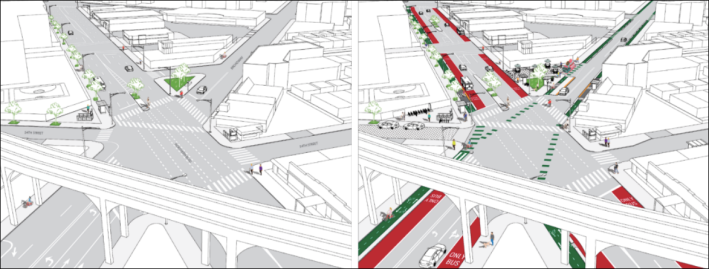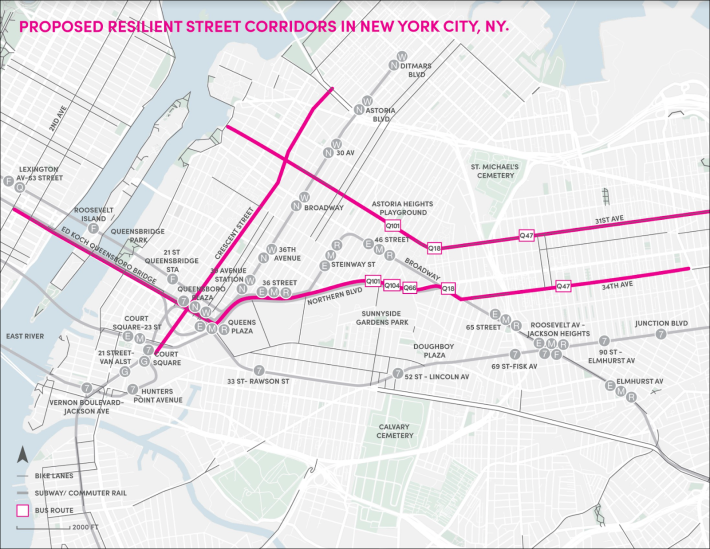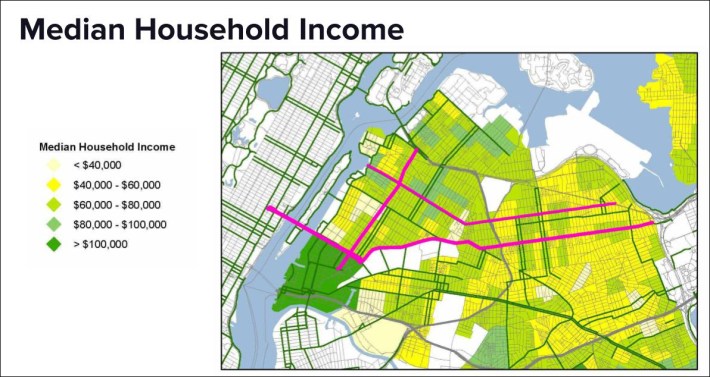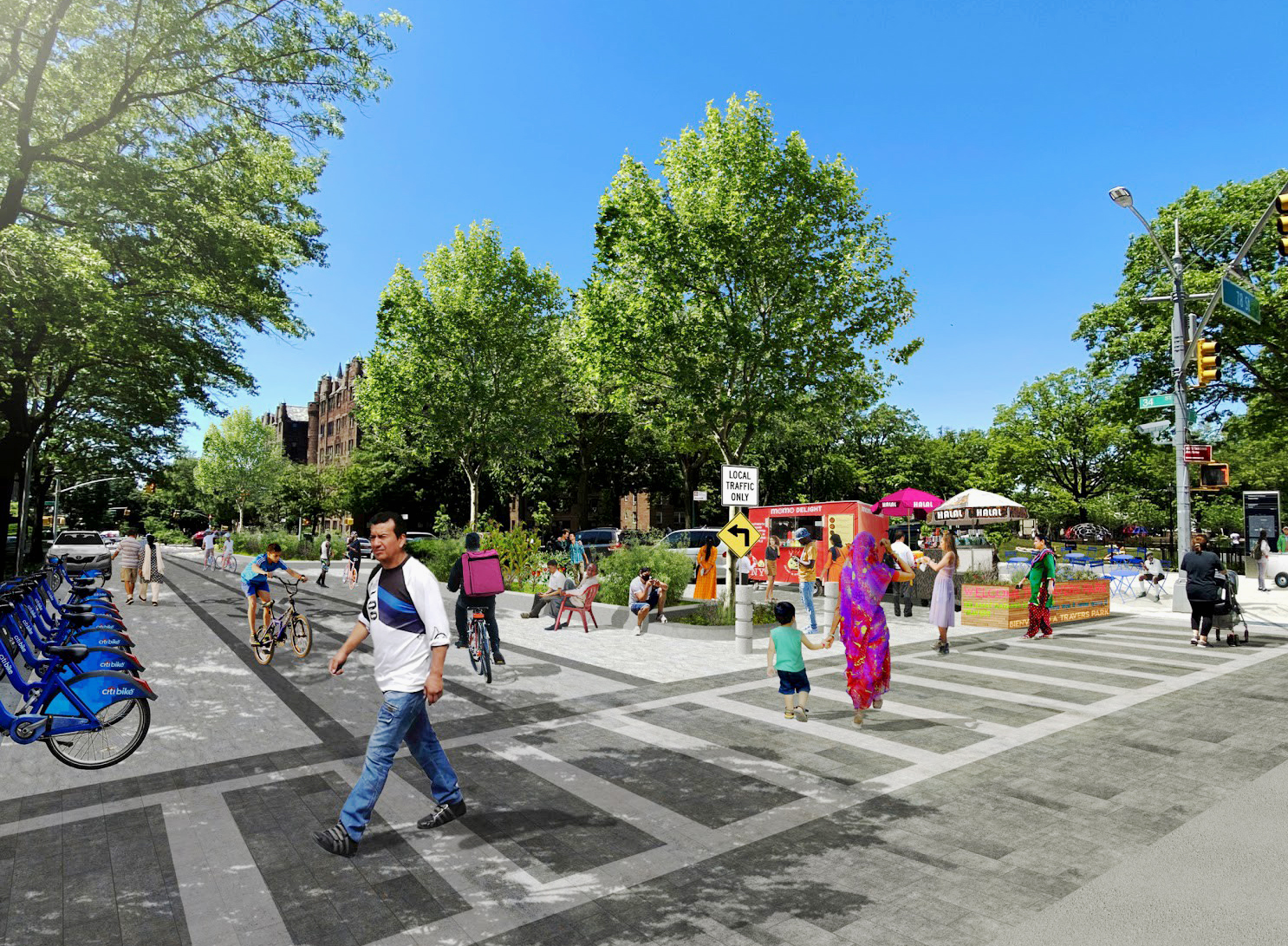Editor's note: With the city facing the specter of car-caused congestion on an epic level due to a massive decrease in transit use, Lyft, which operates Citi Bike, worked with several Queens street safety and cycling groups to promote a new vision for roadways that prioritize more sustainable modes — a clear need that Mayor de Blasio has been told about throughout the coronavirus crisis. The following story — more of a fact-based argument than an opinion piece — was written by the 34th Avenue Coalition, Urban Upbound, Queens Bike, WE Bike NYC, Lyft, Transportation Alternatives and Make Queens Safer. A more detailed version can be found on Medium by clicking here.
The COVID-19 pandemic has sent shockwaves through every part of society, and exposed structural weaknesses that — while previously known — were perhaps not fully understood or appreciated by most. In New York City, the challenges facing our current transportation infrastructure are real and felt — in one way or another — by millions.
With an over 80-percent drop in transit usage related to fears around COVID-19, as well as a recent but troubling rise in car ownership, transportation trends in New York City are in flux and facing uncertain times. What is certain, however, is that driving a single occupancy vehicle every day just isn’t — and can’t be — an option for every New Yorker.
If we do nothing to increase the attractiveness of alternative ways of getting around, more people will buy cars for themselves, taxing our already overburdened infrastructure, spilling more carbon into our atmosphere, and clogging our streets with interminable traffic, with all the street safety, noise, and quality of life concerns that come with it. The costs wouldn’t just be borne by the majority of non-drivers, either. If just 25 percent of current transit and carpool users switch to driving their own car, for example, it would add almost 15 minutes to the average car commute, while costing tens of millions of dollars a day to the economy in congestion related externalities due to lower labor productivity and lost time.
It’s increasingly clear that for our cities and communities to prosper, we need to change the way we build our streets — to better design them for people, and center them on the concept of resilience.
What is a 'Resilient Street'?
A resilient street is a street that prioritizes the efficient movement of people; it is a street that builds redundancy into transit networks by creating multiple, equally attractive options for getting around; and it is a street that is built to manage or mitigate environmental changes that are likely on the horizon. A resilient street is a street that makes social distancing possible: for bus riders, for bike riders, for walking, sitting, and dining. It is a street that is lined with green space for recreating, shade to fight the heat island effect, and ample drainage to combat the possibility of flooding. Resilient streets do not pretend to be blind to the socio-economic history of the communities they run through — rather, they are built to help correct historic injustices by providing greater access for those with the greatest need.
A resilient street works best when it’s connected to other resilient streets, and is of the requisite length and proximity to people that it can facilitate all manner of uses: trips to the local shopping and restaurant hubs, intra-borough travel between neighborhoods, as well as medium-to-long distance (five to eight miles) inter-borough “traditional” commutes to Central Business Districts. Having a high quality bikeshare network — like Citi Bike with both classic bikes and ebikes — only further increases the effectiveness of resilient streets in preventing mode shift toward single occupancy driving.
What Resilient Streets Mean for Queens
As a group, working with the Brooklyn-based Street Plans, we did our best to create a vision for resilient streets in Queens, with a particular spotlight on 34th Avenue in Jackson Heights, and the dangerous intersection of Broadway and Northern Boulevard.

(One note: The image above is a proposed rendering and not a final design. It is merely illustrative and is not intended to replace the full community engagement process.)
Sam Schwartz Engineering also dug into the numbers, and did modeling on what kind of behavior changes a small network of resilient streets in Queens would bring about in the travel patterns of our friends and neighbors.
Due to the latter effort, we learned that Resilient Streets interventions along Crescent Street in Western Queens, as well as along both Northern Boulevard and 34th Avenue (connecting Jackson Heights to the 59th Street Bridge), and 31st Avenue (connecting Astoria to Jackson Heights), could lead to dramatic — and hopeful — changes in the way tens of thousands of people would get around.

With changes to these three corridors, the streets would be able to accommodate 69,000 walking and biking trips every day, which would avoid 290,000 miles of unnecessary individual vehicle travel daily, and ultimately would prevent 31,000 metric tons of carbon from accumulating in our atmosphere annually. It would also undoubtedly save many lives, particularly along Northern Boulevard, currently known as the “New Boulevard of Death” because of its grim record on traffic safety.
Who Would Benefit
These corridors would run through the most diverse neighborhoods in the most diverse county in the world. Indeed, 540,000 total Queens residents live within a mile of these Resilient Street corridors, and about 69% of them rely on public transit to get to work — which is significantly higher than average for Queens. A majority of residents along the corridors are people of color.
Economically, there are a range of income levels along these corridors, including 78,000 low-income households that may not have options to increase transportation spending. These corridors also serve 15,741 residents living in New York City Housing Authority’s affordable housing facilities. And 185,000 people work in education, healthcare, warehousing, transportation, and utilities industries, which represents about 61 percent of total workers in the study area.
We know that, in Queens, households that own cars bring in an average annual income of $85,000, compared to those who take transit or bike, who make $42,000 on average. We also know that transit reliant users, particularly bus riders, are disproportionately people of color and foreign born. So the implications for equity in the borough couldn’t be more obvious and important.

These redesigns would not only increase the number of non-single occupancy vehicle trips total, but they would serve a vital role in saving current Queen’s transit riders and bike riders — who don’t have as many resources in the first place — precious time and money.
Local Action
New York City DOT has already taken great initial steps by committing to redesigns of Crescent Street and Northern Boulevard earlier this spring. They have also shown commitments to 34th Avenue and 31st Avenue by rolling out successful Open Streets programs on them. The more robust and permanent these redesigns, the more success we will have in preventing unwanted mode shift toward single occupancy car usage during this highly volatile time.
Cities Can’t Do This Alone
Ultimately, this will take leadership at both the city and national level. The tools that cities have are well known at this point — particularly when it comes to short-term fixes using lightweight materials like paint, bollards, and planters. However, because of budget crunches hitting cities due to COVID-19 related shortfalls, many of the long-term fixes like permanent infrastructure and continued investment in keeping public transit running will require active support from the federal government. Indeed, it has never been more important for the federal government to step up and support cities and transit agencies doing this vital infrastructure work at the local level.
As part of the most recent surface transit reauthorization bill, there has been an effort to introduce a new $2.4-billion federal grant program to support counties doing infrastructure work on local priorities. This is low hanging fruit that empowers cities by giving them the resources they need to respond to current conditions and anticipate challenges through the creation of truly resilient transportation networks. There is also a bipartisan bill (H.R. 1507) that would reintroduce — and strengthen — the commuter tax benefit for biking to work, including making bikeshare memberships tax deductible.
Congress should enact these provisions right away.
Beyond making more funds available, it is also vital for grant money to be more easily accessible and usable by local agencies. Indeed, it’s important for federal grants to cover expenses for the vital “planning” elements of projects, not simply be narrowly defined for “capital” expenditures. It also makes more sense for the Federal Transit Administration to be the main distributor of funds, rather than the Federal Highway Administration. The latter source often adds years of regulatory process for local agencies. The amount of increased flexibility these simple changes would bring to the ability of city departments of transportation to start, plan, and execute projects would be game changers for the lives of New Yorkers, and countless other Americans.
Get Involved
Here are three ways you can plug in to make change:
- Community advocates at Transportation Alternatives’ Queens Committee are already working to fix Northern Boulevard. Support their committee to bring these changes to life.
- The 34th Avenue Coalition is also working to make the 34th Avenue Open Street permanent. Sign their petition to support their work.
- Sign this petition from People for Bikes calling on Congress to pass the Bicycle Commuter Act, making bike commuters eligible for up to $54 per month in pre-tax benefits.






